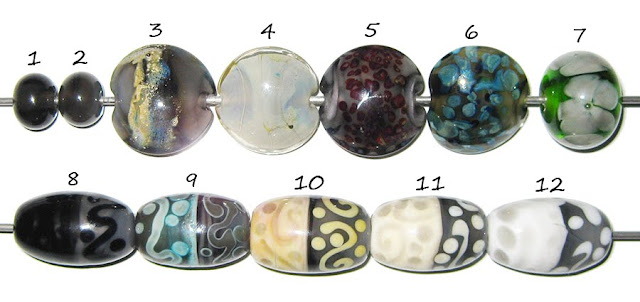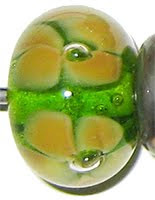I am really, really enjoying this colour. It reminds me of lions, and I've been a lion-lover since I was a baby. I got my first stuffed lion when I was born as a gift from my Dad's mother. She died before I was a year old, so it's the only thing I ever really had that she gave me, and the only thing I have to remind me of her.
When I learned to talk, that lion's name was 'Zozo', since I couldn't yet properly pronounce 'Leo'. Over the years, I accumulated more and more stuffed lions, and I'm not sure if it was a lack of originality or just stubbornness, but ALL of them were (and still are) named Leo. Coincidentally (or maybe not), I am an August baby, and am a Zozo myself.
1 - Plain, 2 - Plain - reduced, 3 - w/ Silver Leaf, 4 - w/ Silver leaf - reduced & encased, 5 - w/ Sasha's Silver stringer - reduced, 6 - w/ TerraNova2 frit, 7 - as a flower, 8 - w/ Copper Green, 9 - w/ Black (Vetrofond), 10 - w/ Opal Yellow, 11 - w/ Ivory (Effetre), 12 - w/ White (Effetre)
The colour of
CiM Canyon de Chelly, depending on how much you strike it and what you put it with ranges from a pale, tawny tan to a rich, variegated gold. It can also look a little more dusky, and be struck to a more pinkish/purply hue. It is a fairly stable colour, and I would label it as 'moderately reactive', because while it can be influenced by other colours, it's pretty good at staying where you put it.
Encasing helps the striking process along, and you can see in the picture above that a little Canyon de Chelly sandwiched between two layers of Clear will strike darker in the centre than on the edges, and will sort of feather out on the edges instead of forming a crisp outline.
Canyon de Chelly is a pretty stiff opaque colour. Copper Green, Ivory, Opal Yellow and White all spread on it, and I bet lots of other colours do too.
Striking / Reduction
When I reduced Canyon de Chelly, it turned a little more dull in colour, and darkened (Bead #2). However, it has also done this for me when I've just repeatedly struck it in a neutral flame, so I'm not convinced that reducing it had anything to do with the colour shift. Repeatedly striking it, however, definitely influences the colour.
Reactions
Worked in a neutral flame, silver brings out the gold in Canyon de Chelly, and blushes it a darker brown. (Bead #3) Reducing and encasing the silver (Bead #4) results in a sort of dirty, mottled brown and silver blanket. I like the non-reduced silver much better. I learned, also, that if you use a lot of silver and silver glass on Canyon de Chelly, the Canyon can get a shiny iridescence when you reduce the bead. Unfortunately, that iridescence is really hard to photograph, so I don't have a pic to show you.
Canyon de Chelly is a good base for silver glass, at least in organics. My Sasha's Silver lines and dots in Bead #4 have a faint shininess to them, and the Sasha's Silver has a cool, mottled blue effect to it. In Bead #5, my TerraNova2 experiment was sort of ruined by me not striking the glass properly, but when I retried it in my straight sided lentils (see the end of this post) I got gorgeous strike from the TerraNova2 on Canyon de Chelly.
You can see in the picture above that the TerraNova2 frit just started to strike before I messed it up, and the purple/red spreading over the Canyon de Chelly is a clue that more striking would have yielded better colour.
There is no strong, visible reaction between Canyon de Chelly and Vetrofond Black, but if you look closely at the Canyon stringer and dots on the left-hand side of Bead #9, there seems to be a faint edging. It's also really cool how the Canyon de Chelly, in a thin layer, looks sort of mottled.
In Bead #8, you can see a couple of different things going on between Copper Green and Canyon de Chelly. First, the Copper Green spreads on the Canyon, and the Canyon de Chelly sinks into the Copper Green. That's why the Copper Green stringer line looks so fat and the Canyon stringer line looks so skinny. Also, a dark line reaction forms between these two colours. The thing that makes this dark line reaction more interesting than other dark line reactions is that it is a reddish-purple colour instead of black or grey. Neat!
All three of these colours (Opal Yellow, Ivory, White) spread on the Canyon de Chelly because it is a relatively stiff colour, but apart from that, the reactions are actually pretty different.
In Bead #10, the Opal Yellow seems almost to raise itself off the bead where it is on the Canyon de Chelly and float a few micrometers above the surface. And the Canyon de Chelly on top of Opal Yellow sinks in a little, but also seems keen to become one with the Opal Yellow -- the edges of the dots and lines are a little blurry, like it's being assimilated.
In Bead #11, on top of Ivory, Canyon De Chelly has separated and developed a thick, strange yellowish outline. I like this effect very much, and will be figuring out a way to use it.
In Bead #12, the Canyon is darker over White than it is over any of the other colours, but apart from that the reaction isn't really unique or interesting.
Here are some other beads that include Canyon de Chelly. What fun! I can't wait to make some more. This colour is a perfect base for organics.









































